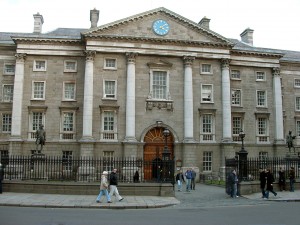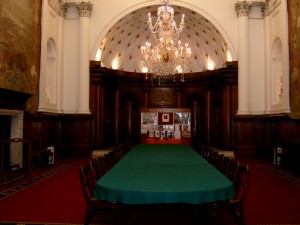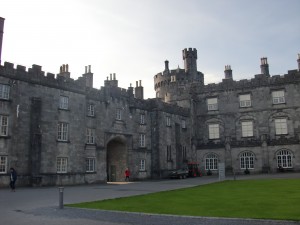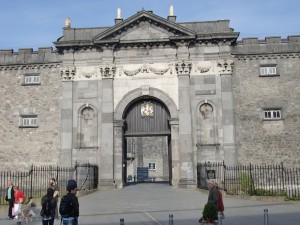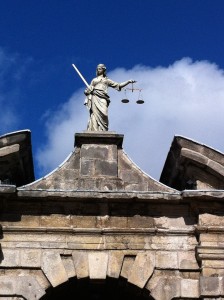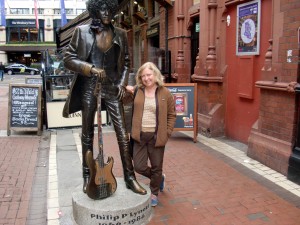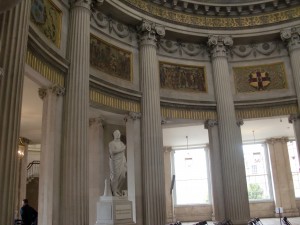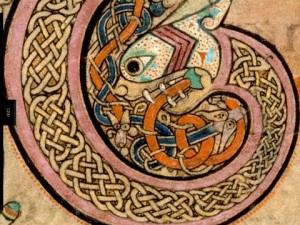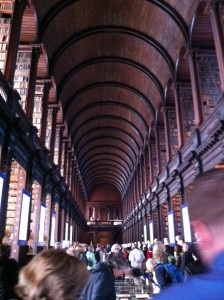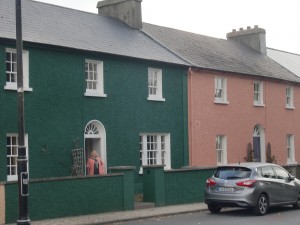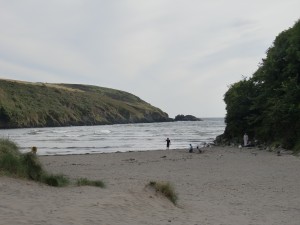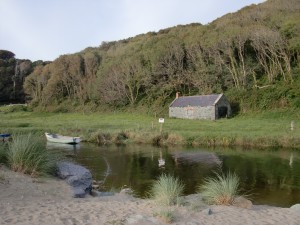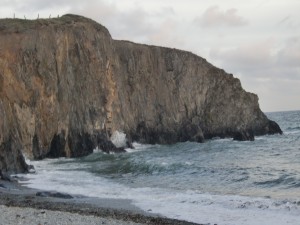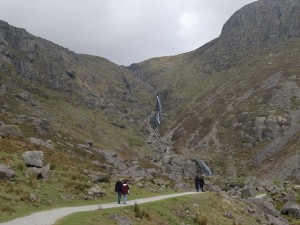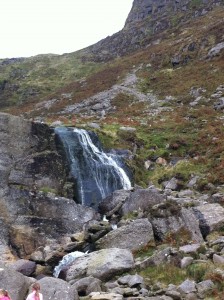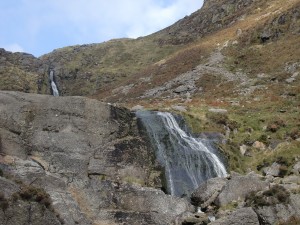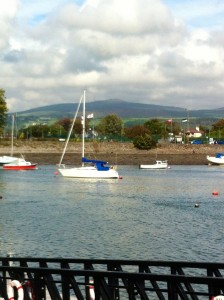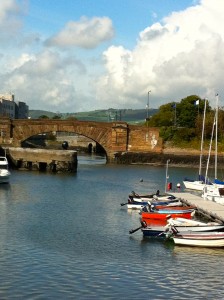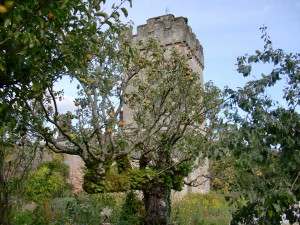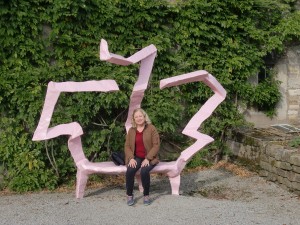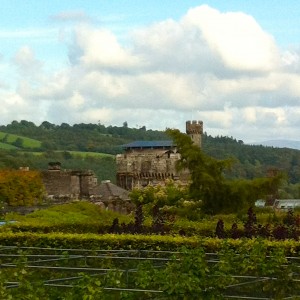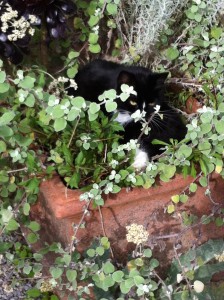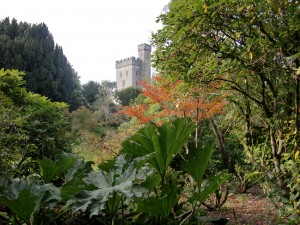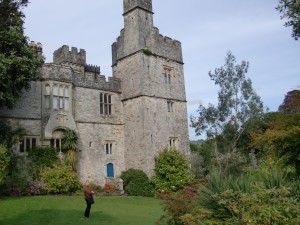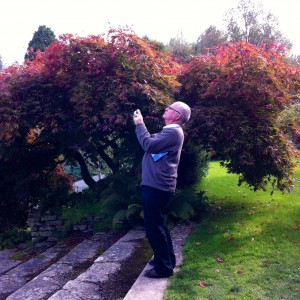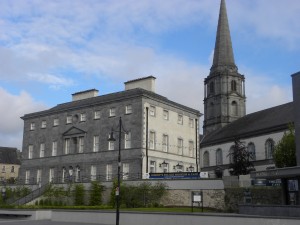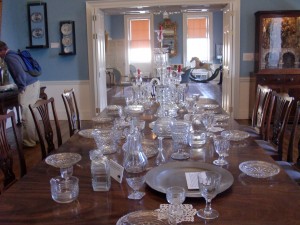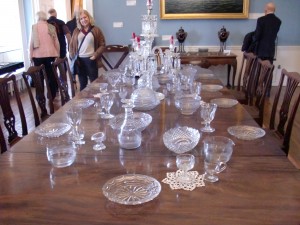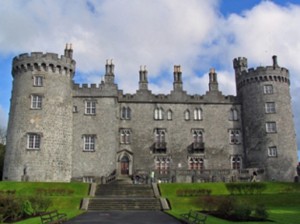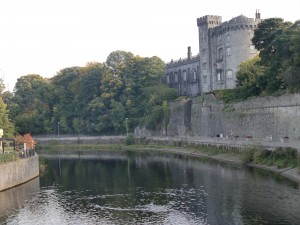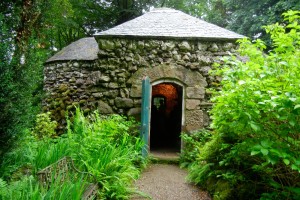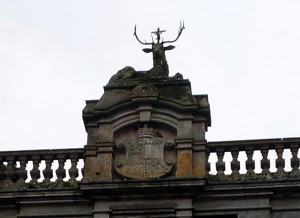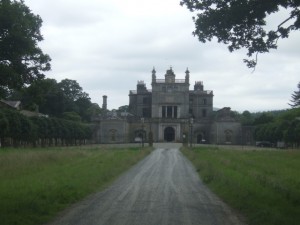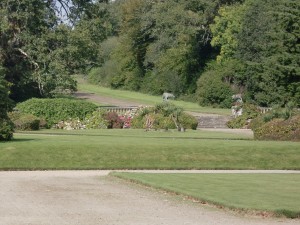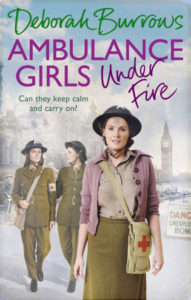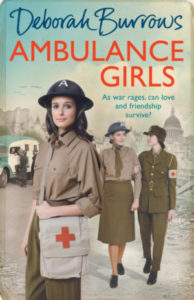I’m at 85,000 words in the Blitz novel and the end is in sight. I’ve been writing in airport lounges, on aeroplanes, in hotels and in cafes, as we’ve been travelling and travelling and travelling. It’s a good thing I can write anywhere…
It was lovely to visit Ireland again. We started in Dublin, where Toby had a workshop to attend at Trinity College, Dubin. We stayed in a lovely hotel near the University and while Toby was at work on the Friday I took a walking tour around the city. A very tall PhD student was the guide, and he was very knowledgeable and had memorised quotes and aphorisms galore, and I learned a lot about the history of that beautiful city. He told us that apparently Ireland is now officially out of recession. He seemed sceptical. In the last few years, or so he said, 800,000 people had left Ireland seeking opportunities overseas. That in a population of a little less than 5,000,000! What interested me was that when he gave statistics or referred to Ireland, it was always ‘this island’, in other words, he always included ‘the north of Ireland’. I asked him what he thought the future held, and his view was that as the rampant Ulstermen got old and died off, the north would eventually just be subsumed into the Republic of Ireland. There are another 1.8 million people in Northern Ireland.
We started our tour at Trinity College, which was filled with students for freshers’ week.
Across the road to the old Parliament House of Ireland, a really beautiful building that was sold and turned into a bank in 1803. It was the first purpose-built Parliament House in the world and when it was constructed in the 1730s, Dublin was the second city of the British Empire. Britain became fearful in the “Year of the French” in 1798. It was then that the United Irishmen, under Wolfe Tone, tried to convince Ireland to rise up against England with the support of the new French Republic. He failed. When he landed with a French expeditionary force, it was a disaster.
In 1800 the British parliament ‘persuaded’ the Irish parliament to vote to disband itself and devolve power to Westminster – our guide likened it to a turkey voting for Christmas. The beautiful former House of Lords, with its coffered ceiling, chandelier, oak panelling and two tapestries which depicted the Battle of the Boyne was kept intact by the bank, as a board room.
In O’Connell Street we saw the statue to Daniel O’Connell, the Great Emancipator of Ireland in the decades after Wolfe Tone. He was enormously popular and successfully campaigned for Catholic emancipation, and achieved it in 1829. In 1841, O’Connell became the first Roman Catholic Lord Mayor of Dublin since the reign of James II in the 1680s (James had been the last Roman Catholic monarch of England, Ireland and Scotland.)
He was utterly opposed to violence, having killed a man in a duel in 1815. So it’s ironic that his splendid monument is riddled with bullet holes from Irish uprisings that occurred in the twentieth century. If you look closely at the statue of the angel you can see a bullet hole under the drapery to the right – a legacy of Ireland’s troubled history.
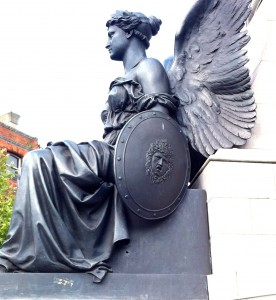
Part of the O’Connell memorial in O’Connell Street

The beautifully decorated Bloom Hotel in Temple Bar
We visited trendy Temple Bar and then went to Dublin Castle, which has been in continuous occupation since it was built in 1204. It was the official seat of British government in Ireland and the symbol of British supremacy for centuries. In 1922, Michael Collins accepted the surrender of the Castle when the Irish Free State was formed.
Our guide pointed out the positioning of the statue of Lady Justice, who does not face out towards the people, but looks inward, towards the Castle. Hence the rhyme, which he quoted:
“The Statue of Justice, mark well her station,
her face to the castle and her arse to the nation!”
And we visited the City Hall, formerly the Customs House.
We also saw the beautiful Book of Kells, which (according to my PhD guide) brings in 6,000,000 euros a year to Trinity College through the hordes of visitors.
Book of Kells Facts: It attracts over 500,000 visitors annually. The manuscript has 340 folios. It is written on calf vellum, with lettering in iron gall ink. The colours were imported from far away lands and are made from plant and animal pigments. It is named after the Abbey of Kells in Co Meath where it lived for centuries. The ms was never finished, but what there is may be viewed on the Library’s Digital Collections portal.
Upstairs is the beautiful Long Room, which dates from the 18th century, and houses 200,000 of the Library’s oldest books in its oak bookcases.
We left Dublin on Saturday in a hire car and drove down to the pretty little village of Stradbally in Co Waterford, to stay in a cottage belonging to a friend of ours, who inherited it from his aunt. I’m standing in the doorway of the green cottage in my pink coat – what colour co-ordination, you gasp. The row of cottages date back to the early nineteenth century and our cottage was just perfect. We were met by the delightful neighbour Eileen, who is the holder of the keys, and we waved to the delightful Eileen, the other neighbour who apparently knows everything there is to know about Stradbally.
Stradbally is on the “Copper Coast” road, and it is a picturesque village of neat thatched and slated cottages. It wasn’t surprising to hear that it has won numerous awards in the National Tidy Towns Competition as the residents keep it immaculately. It is surrounded by trees – these were first planted by the Fitzgeralds in the 18th century, and as the guide book says, they ‘give the area an unusual tamed, sylvan character which contrasts with the wild stretches of windswept coast’.
Two coves are within walking distance of the village. Stradbally Cove has a pretty river flowing into it and a sandy beach. It would be ideal for swimming (if you could bear the freezing water) but, sadly, the signs warn against bathing there because it is polluted by the village’s sewage works.
A few miles down the road, at the end of a pleasant walk, is rugged Ballyvooney Cove, spectacularly set under a dramatic headland. It has a pebble beach.
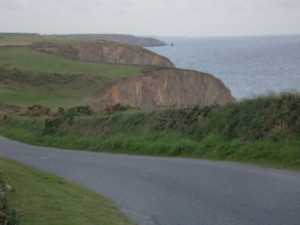
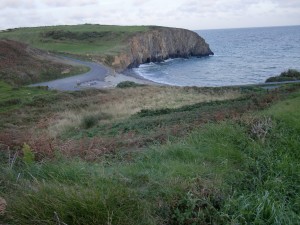
The Church of Ireland church in the village has in its grounds a substantial ruin of the largest medieval church in rural Ireland. It contains a fortified presbytery, probably built for protection during the disputes between the Powers and Fitzgeralds, whose boundary lands ran through the area.
We went for a drive the next day, into the ruggedly beautiful Comeragh Mountains. The twelve mountains which form the group are very popular for mountain climbers and hikers, as we found out when we went to visit the waterfall. The highest point in the Comeraghs is 792 m (2,598 ft).
And we drove to pretty Dungarvan for lunch by the harbour. The town stands at the mouth of the Colligan River. Sadly, while we were there someone cannoned into our hire car, which was parked on the street, and scraped the side badly. I must say that the Irish are dreadful drivers!!! I really think they may be worse than Perthites, which is astounding. But maybe it’s because there is so little traffic on the roads. It was really lovely to have beautiful scenic roads almost to ourselves – compared with crowded England.
And from there to Lismore Castle gardens, which were a picture of early autumn beauty. The stately home (which is not open to the public) has belonged to the Dukes of Devonshire since 1753. The present Duke’s son, Lord Burlington, is in residence. In the gardens we found the deliciously creepy Yew Walk, where Spenser thought up some of The Faerie Queene.
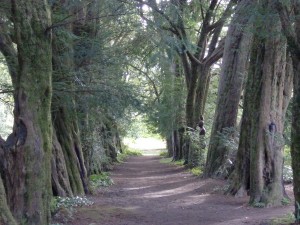
The Yew Walk
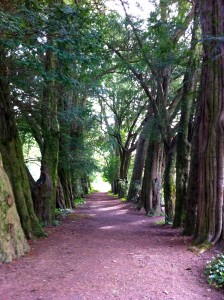 Perhaps it was the inspiration for this canto:
Perhaps it was the inspiration for this canto:
Enforst to seeke some covert nigh at hand,
A shadie grove not far away they spide,
That promist ayde the tempest to withstand:
Whose loftie trees yclad with sommers pride
Did spred so broad, that heavens light did hide
Everywhere now there are apple trees laden with fruit, and Lismore was no exception. The trees really are so lovely, with their red jewels of apples peeping out from gnarled branches.
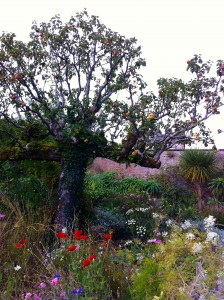
On Monday we drove into Toby’s mother’s mother’s ancestral home, Waterford – the oldest town in Ireland. Toby’s family were cattle traders in the town. Viking raiders first established a settlement near Waterford in 853, but were driven out by the native Irish in 902. The Vikings returned in 914 and this time they stayed until 1170, when Diarmait MacMurchada, the deposed King of Leinster, took Waterford with the assistance of the Norman Earl of Pembroke, known as Strongbow.
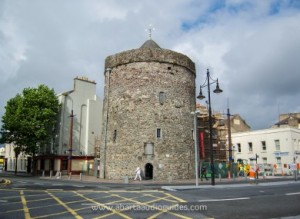
Reginald’s Tower
We visited a museum in what used to be the Bishop of Waterford’s Georgian house, and also saw medieval exhibits in what used to be the cellars of a medieval merchant’s house. This is a Viking stone tower (Reginald’s Tower) on the long and impressive quay.
The next day it was off to Kilkenny, where we visited the castle.
On our last day in Ireland we visited Curraghmore, the seat of the Marquis of Waterford. The house itself looks forbiddingly gothic. It’s actually a Norman keep encased in a Victorian mansion. A castle was erected on the site in the twelfth century, but the core of the current house is a medieval tower-house, which was extended in 1700 when a house was built around a court and the medieval tower-house was incorporated at the north-eastern side. The De La Poer family have been there since 1167, but they became the Beresfords in the eighteenth century, and it was then that a forecourt with stables was added and the house was refurbished in the 1780s. Curraghmore House is surrounded by 2,500 acres of formal gardens, woodland and grazing fields, which makes it the largest private demesne in Ireland.
There was a lovely little shell grotto built in the gardens by Catherine, Countess of Tyrone in 1754. The shells are from all over the world and she got them from sailors who docked at Waterford.
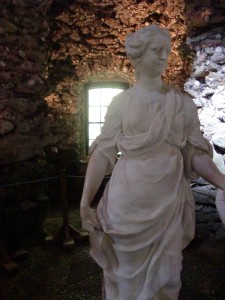
The Countess in her grotto.
On the castle keep, looking down on visitors, is a St Hubert’s Stag, a deer’s head with a cross between its antlers:
The caretaker/guide told us that the stag saved the house from burning in the 1920s. The IRA had straw along the top of the house ready to set the match. But there was a full moon over the lake and it shone onto the cross which shone onto the courtyard. The man who was about to light the bales thought this was a sign from God so didn’t light the bales. And so the house is still standing.
They left Curraghmore and on that same night burnt the Woodstock House in Inistioge, Co. Kilkenny. The guide told us that Woodstock House is now simply a beautiful garden around a ruined house.
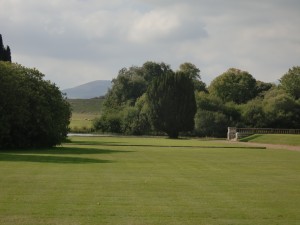
It was getting late by the time we left Curraghmore, so we drove hell for leather to the airport . . . to just miss the plane. Not to worry – it was then we discovered that we’d left our passports in the hotel safe in Dublin when we’d departed for Waterford four days before.
A hurried phone call to the hotel ensued. The girl on the desk asked if we could wait until the maid saw to the room the next morning. She was told, no we couldn’t. She said she’d send someone to check the room. We thanked her, and sat at the airport, surrounded by our luggage, wondering if the passports would still be in the safe.
The phone rang and a young man from the hotel told me, ‘I’m delighted to tell you that I’ve your passports in me hand right now. I’m looking at them.’
At our request, he sent them to the airport by taxi, and when Toby picked them up outside the terminal the taxi driver said, ‘You’d be surprised how often I’ve had to do this.’
We got the 11.00 plane back to Birmingham and were in Oxford by around 1.00am.
Four days later and we flew to Madrid, but that’s another story…

